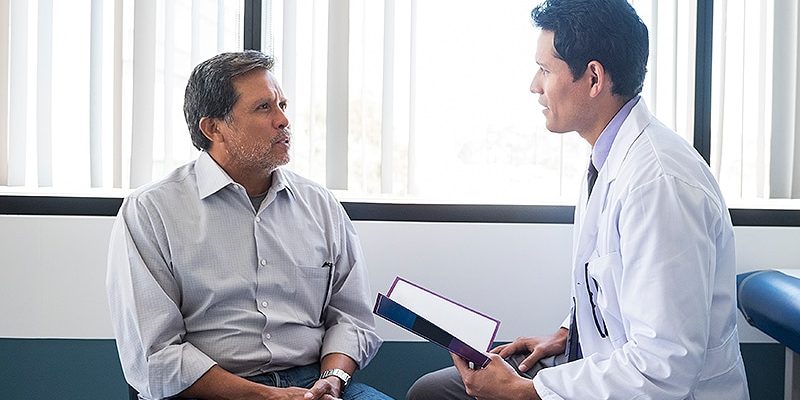Patients with cancer are more likely than non-cancer patients to delay or halt treatment because their clinician is of a different race, religion, gender, or other identity, according to a new analysis. The study emphasizes the need to increase physician diversity across the workforce and to better match clinical care to patient culture, say commentators.
The findings emerged from an analysis of records of 131,514 people enrolled in the National Institutes of Health “All of Us” research program. In all, 7.6% of people who had undergone cancer treatment reported delaying or forgoing medical care because of a perceived “identity discordance” with their clinician, vs 5.1% of cancer-free individuals (P < .001). The results were published as a research letter in the May issue of JAMA Oncology.
“We believe that this is the first really robust evidence we have that clinician diversity actually impacts a patient’s decision to seek care,” commented lead author Vishal Patel, BS, a medical student at the University of Texas.
The finding that patients with cancer were more likely to be put off care was at first “surprising,” Patel told Medscape Medical News. “It suggests that there’s something about cancer that might make the patient to be more cognizant of who their provider is.”
Patel speculated that cancer care might be particularly vulnerable to this effect because it concerns life and death: “Discussions about cancer survival, treatment, [and] prognosis differ from culture to culture, differ widely,” he said, “So it does make sense that [in] this particular disease [identity concordance] has more impact.”
Patel added, “There’s a very clear solution to this, which is to increase the diversity of the physician workforce.”
The “All of Us” research program includes a healthcare utilization survey that asks participants if they have “ever delayed or forgone care because their clinician was of a different religion, native language, or other identity”.
Patel and colleagues assembled a group of 21,919 cancer survivors (people currently or previously receiving cancer treatment) who had completed the “All of Us” survey. The researchers compared the cancer survivors’ survey answers with those of 109,595 cancer-free participants matched for age, gender, race, and ethnicity.
Age seemed to be a factor when it came to weighing up the clinician in front of them. Younger patients were more likely than older patients to be bothered by the fact that their clinician had a different identity to themselves.
For example, depending on income, 18%–29% of racial and ethnic minority adults younger than age 45 said they had forgone care because of identity discordance, vs just 4%–12% of the over-65s. A similar trend was seen among non-Hispanic White individuals when it came to age, but annual income had a greater mitigating effect. Approximately 27% of younger White people on a low-income (<$25,000 a year) had problems with identity discordance vs only 6% of those on a high income (>$150,000 a year).
“Young adults…may have heightened sensitivity to perceived identity discordance,” the authors speculated. They cite a 2013 Pew Research Center survey that found that adults aged 18-29 were more likely than those older than age 65 to state that Muslims, Hispanics, ‘gays’, and non-Hispanic Black people face “a lot” of discrimination (N = 1504).
“Patient-clinician identity discordance remains a barrier to care for many cancer survivors and should be addressed,” Patel and co-authors concluded.
The issue was discussed by speakers at a recent meeting held by the National Comprehensive Cancers Network (NCCN) in Washington, DC, entitled Cancer Across Geographies. Experts who provide oncology services to remote communities cited examples of adapting cancer care to the patient’s identity.
Mei Wa Kwong, JD, executive director of the Center for Connected Health Policy, the federally designated national resource center on telehealth policy, described the center’s experience with a telehealth project for 42 community healthcare clinics in California.
The health-clinic staff were reluctant to host an outside clinician, Kwong said: “They [said], ‘This is a large Latino population, they primarily speak Spanish, you’re sending in these White doctors…?’ “
Kwong’s team put together a roster of physicians who were either Latinx or spoke Spanish fluently. “That immediately put the clinic staff at ease and they worked hard to build those bonds [with the participants],” Kwong said.
Joette Walters, CEO of Tuba City Regional Health Care Corporation, Navajo Nation, Tuba City, Arizona, described Tuba’s new Specialty Care Center, the first-ever cancer center on traditional tribal lands, where oncologists work alongside traditional healers.
Prior to the creation of the center in 2019, cancer patients had to drive more than 100 miles to receive care outside the reservation. Walters emphasized that this involves traveling many miles to “a place that’s not familiar with your culture, maybe doesn’t speak your language, doesn’t eat your foods, doesn’t understand your traditional beliefs and customs.”
These cultural barriers combined with transportation difficulties meant that, prior to the creation of the new center, many people decided not to pursue cancer treatment, said Walters.
Ursa Brown-Glaberman, MD, medical director of the University of New Mexico Comprehensive Cancer Center’s Clinical Research Office, described a study in which the research team partnered with an American Indian artist to develop “culturally competent” recruitment materials.
“Seeing the difference between handing someone a black-and-white consent form and something that was designed specifically for them — it’s phenomenal, amazing, what a difference that can make,” she said.
Patel and co-authors report no relevant financial relationships. Panelists at the NCCN Oncology Policy Summit did not provide conflict of interest declarations.
JAMA Oncol. Published in the May 2023 issue. Research Letter
For more from Medscape Oncology, join us on Twitter and Facebook
Source: Read Full Article
